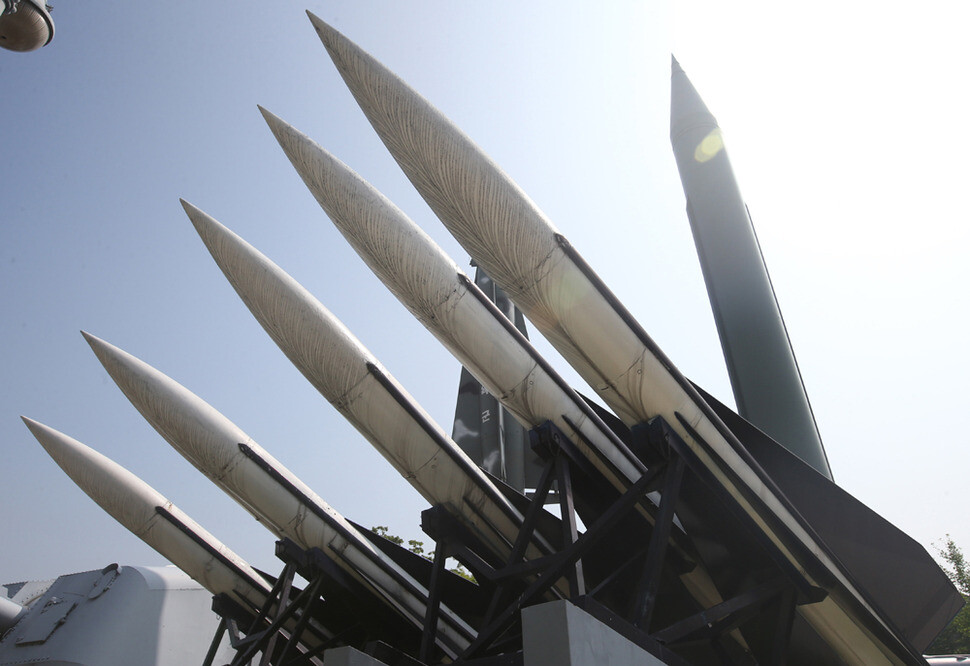hankyoreh
Links to other country sites 다른 나라 사이트 링크
North Korean missile launches spurred rushed announcement of THAAD deployment

It was recently discovered that the decision of the South Korean and US governments to deploy the Terminal High Altitude Area Defense, or THAAD, was directly linked to North Korea’s ballistic missile and rocket launch. This has aroused suspicions over whether the two governments had been in preparations for THAAD deployment from the outset, only now taking full advantage of the public anxiety that followed the succession of North Korean missile launches.
The issue of THAAD deployment on the Korean peninsula became a major issue at a forum held in June 2014, where Curtis Scaparrotti, then Commander of the United States Forces Korea, revealed that he had recommended THAAD deployment. It was four months after North Korea had launched its Rodong missiles at a high trajectory, attaining an altitude of 160 km. After this experiment in firing at a high trajectory, some argued that THAAD deployment was necessary because the Rodong missile, when fired at a high trajectory, descends too quickly to be intercepted by Patriot missile systems. Scaparrotti’s remarks escalated the issue.
As the controversy grew, the government stayed silent, only repeating the so-called “three no‘s,” saying that there was no U.S. government request, there was no agreement, and there was no decision made. Then, on Feb. 7, the day that North Korea launched its long-range Kwangmyongsong-4 satellite, the South Korea government officially announced that it would come to an agreement on THAAD deployment with the US government.
It was a surprise announcement, made in a situation of heightened public anxiety, after North Korea’s fourth nuclear test on Jan. 6, and the subsequent rocket launch. The Ministry of National Defense announced at the time that “Following North Korea’s fourth nuclear test, Washington proposed that we reach an agreement on THAAD deployment, and we accepted after deliberation.” The US government had used North Korea’s nuclear test, and the South Korean government had used North Korea‘s long-range rocket launch, as a stepping stone towards THAAD deployment.
Preceding this decision of THAAD deployment was North Korea’s launch of the Musudan intermediate-range ballistic missiles on June 22. A Defense Ministry official hinted at the connection between the THAAD decision and the launch of the Musudan missiles, saying that “Seoul and Washington sped up its decision on THAAD deployment following the firing of the Musudan missiles last month.” But given that the Musudan IRBM has an estimated range of more than 3000 km, and is thus more of a threat to the U.S. naval base in Guam than to South Korea, it is likely that this sudden announcement of THAAD deployment was led by the US.
In related news, Japanese newspaper Asahi Shimbun reported that on July 10, South Korea had proposed that the announcement of THAAD deployment be pushed back to the yearly Korea-US Security Consultative Meeting in October, but that the US had pressured South Korea into moving up the announcement. South Korea had reportedly been planning to explain South Korea‘s policies and ask for understanding regarding THAAD deployment at a separate summit with China at the 2016 G20 Hangzhou summit in China, and then announce the actual deployment at the Security Consultative Meeting in October.
By Gil Yun-hyung, Tokyo correspondent
Please direct questions or comments to [english@hani.co.kr]

Editorial・opinion
![[Column] Park Geun-hye déjà vu in Yoon Suk-yeol [Column] Park Geun-hye déjà vu in Yoon Suk-yeol](https://flexible.img.hani.co.kr/flexible/normal/500/300/imgdb/original/2024/0424/651713945113788.jpg) [Column] Park Geun-hye déjà vu in Yoon Suk-yeol
[Column] Park Geun-hye déjà vu in Yoon Suk-yeol![[Editorial] New weight of N. Korea’s nuclear threats makes dialogue all the more urgent [Editorial] New weight of N. Korea’s nuclear threats makes dialogue all the more urgent](https://flexible.img.hani.co.kr/flexible/normal/500/300/imgdb/original/2024/0424/7317139454662664.jpg) [Editorial] New weight of N. Korea’s nuclear threats makes dialogue all the more urgent
[Editorial] New weight of N. Korea’s nuclear threats makes dialogue all the more urgent- [Guest essay] The real reason Korea’s new right wants to dub Rhee a founding father
- [Column] ‘Choson’: Is it time we start referring to N. Korea in its own terms?
- [Editorial] Japan’s rewriting of history with Korea has gone too far
- [Column] The president’s questionable capacity for dialogue
- [Column] Are chaebol firms just pizza pies for families to divvy up as they please?
- [Column] Has Korea, too, crossed the Rubicon on China?
- [Correspondent’s column] In Japan’s alliance with US, echoes of its past alliances with UK
- [Editorial] Does Yoon think the Korean public is wrong?
Most viewed articles
- 1‘We must say no’: Seoul defense chief on Korean, USFK involvement in hypothetical Taiwan crisis
- 2N. Korean delegation’s trip to Iran shows how Pyongyang is leveraging ties with Moscow
- 3Amnesty notes ‘erosion’ of freedom of expression in Korea in annual human rights report
- 4[Column] Park Geun-hye déjà vu in Yoon Suk-yeol
- 5‘Weddingflation’ breaks the bank for Korean couples-to-be
- 6[Reportage] On US campuses, student risk arrest as they call for divestment from Israel
- 7[Editorial] New weight of N. Korea’s nuclear threats makes dialogue all the more urgent
- 8Why Korea shouldn’t welcome Japan’s newly beefed up defense cooperation with US
- 9[Guest essay] The real reason Korea’s new right wants to dub Rhee a founding father
- 10Will NewJeans end up collateral damage in internal feud at K-pop juggernaut Hybe?